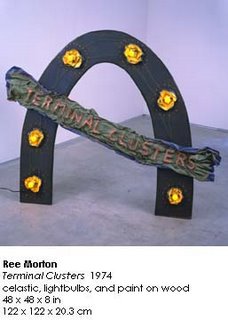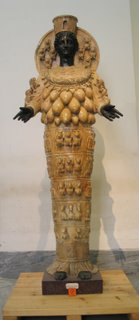I receive several emails a day from e-Flux, a subscription service that sends out press releases for exhibitions all over the world. I get many I don't care about, but it's a great service because it's astounding how many exhibits are going on all of the time all over the place, plus it's the best way to be alerted to things I do care about but didn't know was happening. It's also the best way to read some of the most astoundingly asinine curator's statements with tremendous convenience. And it's also the best way to see who is hot, at least among curators- when you see Liam Gillick's name in at least one press release a week over a few months, you kind of wonder if he's really that great, or whether he's really cute or a great partier. I have no idea. Anyway, at the very least perhaps it's the art version of staring at the cover of People and Us while standing in the checkout line at the grocery store.
Maybe almost a couple of months ago I received an announcement for a soon to open show called High Times, Hard Times: New York Painting 1967-1975. The press release says:
High Times, Hard Times not only captures a tumultuous period of political and social change, but also reflects the impact of the civil rights struggle, student and anti-war activism, and the beginnings of feminism in the art world. Painting is the one element usually left out of this complex narrative, remembered only as a regressive foil to the various new mediums. But this version of the story greatly oversimplifies the situation, effacing painting that earned a place among the most experimental work of the moment, very much in sympathy with the era’s radical aesthetics and politics...
Artists in Exhibition
Jo Baer, Lynda Benglis, Dan Christensen, Roy Colmer, Mary Corse, David Diao, Manny Farber, Louise Fishman, Guy Goodwin, Ron Gorchov, Harmony Hammond, Mary Heilmann, Ralph Humphrey, Jane Kaufman, Harriet Korman, Yayoi Kusama, Al Loving, Lee Lozano, Ree Morton, Elizabeth Murray, Joe Overstreet, Blinky Palermo, Cesar Paternosto, Howardena Pindell, Dorothea Rockburne, Carolee Schneemann, Alan Shields, Kenneth Showell, Joan Snyder, Lawrence Stafford, Pat Steir, Richard Tuttle, Richard Van Buren, Michael Venezia, Franz Erhard Walther, Jack Whitten and Peter Young.
I instantly ordered the catalog, and I'm glad I did.
In 1976 I was attending a local community college, trying to figure out if I was going to go into journalism or art. Or something else. The short story about that is that I just kept doing what interested me and I did the art thing. It was like it was never really a question. I just followed myself.

Dan Christensen: Pavo, 1968, Acrylic on canvas
I was a lousy student, and I still am, in the sense that I've never liked going to class, never liked the assignments, and have always learned best on my own, even if it takes my three times the amount of effort to learn something on my own. And I didn't want to learn about art by practicing perspective and making color charts. I liked drawing the figure, and I liked the studio classes because I could come late and leave early and do all of my work at home without anyone else around.
Once I discovered Abstract Expressionism, at age 18, and about twenty years too late, I found it hard to be engaged by much else except for the Bay Area figure painters like Diebenkorn and Park. But that's another story to tell, about how long it took me to not see art as a bunch of file drawers and a timeline, but rather as a large amoebic thing where painters from all eras have so much in common. And I had to figure that out on my own, too. But I did manage to figure out something about NY painting of the 60's and 70's, and it wasn't until I started thinking about High Times, Hard Times that I realize what an impact painting of that era had on me.
Somehow in that first year of college I figured out that the library had periodical stacks. I was already checking out books, but I didn't really know how to use a library and I didn't know anything about the treasure trove of material there. I can't recall how I figured it out, but I think I accidentally stumbled on the stacks while looking for one section in the library.

Source
I did what lots of art students did (do they still?): when I discovered the back issues of art magazines I started poring over them- Artforum, Art in America, Arts, Art News, Studio International, Kunst. There must have been others. And I started from the present day working backwards. And then I figured something else out- lots of books and articles in magazines have footnotes. If I was reading an article about Frank Stella in Artforum that referenced a Donald Judd review of Stella in Artforum five years earlier I could go read that. It was like reading a dialog. Amazing.
Beginning with 1976, I started working backwards through the magazine into the mid-sixties, reading articles and reviews. And when I saw the press release for High Times, Hard Times it just hit me- I know all of those artists, I like that work, and come to think of it, much of that stuff has been pretty important to me, even up until today. Steir, Gorchov, Tuttle, Benglis, Fishman, Young, Baer, Palermo- I think about that stuff. Work that might seem less relevant to me- Pindell, Loving, Lozano, Christensen, Schneeman- no, no, that stuff is great. All of that had a great imprint on me, and it comes out of a very interesting period that the catalog for the exhibition makes clear- political unrest, drugs, music, civil rights, assassinations- these events are part of the landscape of my adolescence. These events have had a significant impact in shaping how I see the world and what I expect of it, and the art of this period included in this exhibition, which has been somewhat forgotten or ignored, has also had a similar hand in this.
I'm really happy that this work is getting another look now. I think much of what it deals with is still tremendously relevant, and probably still not fully digested and understood. And I'm really happy that these artists, some of whom have not been much in the public eye for sometime, are getting a second chance.
There is much more to say about this topic, How Far Back and How Far Afield Do I Look?- this is just a taste.
